The brightest planets in October's night sky: How to see them (and when)
Our guide for viewing the planets tells you when is the best time to see them during the month ahead as well as other skywatching sights to look out for.
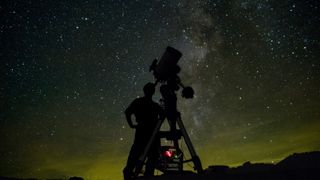
Slowly but surely, Venus is making itself evident in the evening sky. It is still quite low near the southwest horizon shortly after sunset, but as the month progresses it climbs a little higher and sets a little later, although even by month's end it's still setting only about 45 minutes after sundown.
Saturn is in the best position to view, already well up in the southeast sky at dusk and is visible for most of the night. Jupiter is far brighter than Saturn, but you'll have to wait until mid-to-late evening to see it, rising in the east-northeast. Your best views of it will come between midnight and dawn as it ascends the south-southeast sky against the backdrop of the stars of Taurus the Bull.
Pumpkin-hued Mars follows Jupiter, trailing it by an hour, rising around midnight. This is becoming an exciting time to track Mars, for as Earth continues to draw closer to it, as a consequence it will slowly get brighter. In October, we can categorize it as a "bright" starlike object. In November it will be "very bright" and by December it will be "brilliant."
Finally, there is little Mercury, which by month's end is positioned very low near the west-southwest horizon right after sunset, but it is debatable whether it will be available to most skywatchers, even with binoculars.
Related: Night sky, October 2024: What you can see tonight [maps]
Read more: Best telescopes for seeing planets in 2024
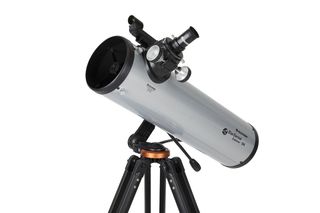
Looking for a telescope for the next night sky event? We recommend the Celestron StarSense Explorer DX 130AZ as the top pick for basic astrophotography in our best beginner's telescope guide.
In our schedule, remember that when measuring the angular separation between two celestial objects, your clenched fist held at arm's length measures roughly 10 degrees. Here, we present a schedule below which provides some of the best planet viewing times as well as directing you as to where to look to see them.
Be sure to check out our best telescopes for viewing planets guide and our more general guides for the best binoculars and the best telescopes. If you're interested in taking your own impressive skywatching images, we have recommendations for the best cameras for astrophotography and the best lenses for astrophotography.
Mercury

Mercury passed superior conjunction on Sept. 30. On Halloween (Oct. 31) this speedy little planet will be 18 degrees east of the sun, but it's so low in bright twilight that you'll need binoculars to spot it, as it will set less than 45 minutes after sundown as seen from latitude 40-degrees north. Of magnitude -0.3, Mercury should be a naked-eye object for the southernmost United States, where it will set nearly an hour after the sun. For observers at the equator, Mercury will set as twilight ends.
Venus
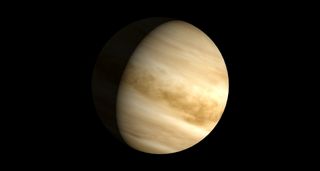
Venus creeps a little higher as October progresses, now improving by about 10 degrees high 45 minutes after sunset for observers around latitude 40 degrees north. On the evening of Oct. 5, half an hour after sunset, look low toward the southwest horizon for a view of dazzling Venus situated 4 degrees to the upper right of a slender crescent moon. Binoculars will be beneficial in seeing both against the bright twilight sky. A low-power scope can also reveal the wide double star Alpha (α) Librae (Zubenelgenubi). Venus and the star are less than 1 degree apart. On the evening of Oct. 26, it passes 3° north of the ruddy star Antares (only 1% as bright). Use binoculars.
Mars
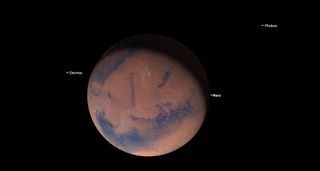
Mars comes up just before midnight on Oct.1; an hour earlier by Oct. 31. When dawn breaks, it has climbed high in the south-southeast sky. The "Red Planet" (which actually looks more orange than red) begins the month shining at magnitude +0.5 some 10-degrees from the 1st-magnitude star Pollux, which is a paler orange and shines only about half as bright at magnitude +1.2. An isosceles triangle formed by the nearby star Castor, Pollux and Mars on Oct. 1, gradually transitions into a nearly straight line on Oct. 30. By then, Mars will have brightened to magnitude +0.1, surpassing bluish Rigel in Orion — the seventh brightest star — in brightness. In telescopes, the Martian disk is tiny but growing. Can you see that Mars is slightly gibbous? That's due to the fact that it's at quadrature, 90 degrees west of the sun, on Oct. 14th. On the 24th, Mars will keep company with the last quarter moon, sitting half a dozen degrees to the moon's upper right.
Jupiter
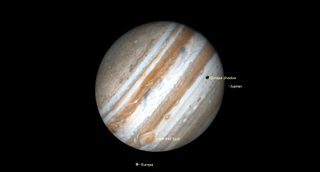
Jupiter rises shortly after 10 p.m. (daylight saving time) on Oct. 1 and around two hours earlier on Oct. 31. The giant planet brightens slightly during the month, from magnitude -2.5 to -2.7, and through telescopes, its disk enlarges by more than 8%. Jupiter is well north of the celestial equator, so it's high enough for excellent telescopic observation by midnight. But it's literally soaring high in the south, a few hours before dawn. Jupiter is in Taurus east of Aldebaran and the Hyades. It halted its direct (eastward) motion relative to the stars on Oct. 9 and begins to retrograde slowly back toward Aldebaran, narrowing the gap only slightly from 12 degrees to 11 degrees. On the morning of Oct. 21, you'll no doubt notice that Jupiter will be sitting 5½-degrees to the lower right of the moon.
Saturn
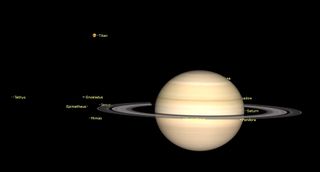
Saturn through October, is well up in the southeast at nightfall and reaches its peak altitude in the south around mid to late evening. It's by far the brightest thing in Aquarius — a steady yellow light of magnitude +0.7. Saturn seems an outcast in this relatively dull region of the sky. The only naked-eye star within a few degrees of it is Lambda (λ) Aquarii, magnitude +3.7. In a telescope, Saturn's rings appear more tilted (5°) than they were during the spring and summer. And Saturn never lacks close company: its largest moon, Titan, shining with an orange hue, is bright enough to show at 25x in a small telescope. On Oct. 14, at dusk, look about one-third up in the southeast to see a waxing gibbous moon and about 4 degrees to its right will be Saturn.
Joe Rao serves as an instructor and guest lecturer at New York's Hayden Planetarium. He writes about astronomy for Natural History magazine, the Farmers' Almanac and other publications.
Editor's Note: If you get a great photo of any of the planets and would like to share it with Space.com's readers, send your photo(s), comments, and your name and location to spacephotos@space.com.
Join our Space Forums to keep talking space on the latest missions, night sky and more! And if you have a news tip, correction or comment, let us know at: community@space.com.
Get the Space.com Newsletter
Breaking space news, the latest updates on rocket launches, skywatching events and more!

Joe Rao is Space.com's skywatching columnist, as well as a veteran meteorologist and eclipse chaser who also serves as an instructor and guest lecturer at New York's Hayden Planetarium. He writes about astronomy for Natural History magazine, the Farmers' Almanac and other publications. Joe is an 8-time Emmy-nominated meteorologist who served the Putnam Valley region of New York for over 21 years. You can find him on Twitter and YouTube tracking lunar and solar eclipses, meteor showers and more. To find out Joe's latest project, visit him on Twitter.
-
rod Good to see in the report Starry Night used for some charts. I use and enjoy very much in my stargazing as well as planet observations and asteroid tracking like 4 Vesta in Cetus now, moving retrograde. In my observation log (MS ACCESS DB), I load up views of the sky from Starry Night into my log entry along with various ephemeris generated that I import into Excel - works very well.Reply